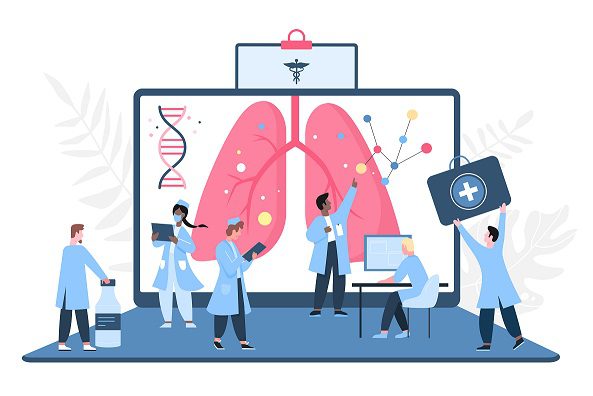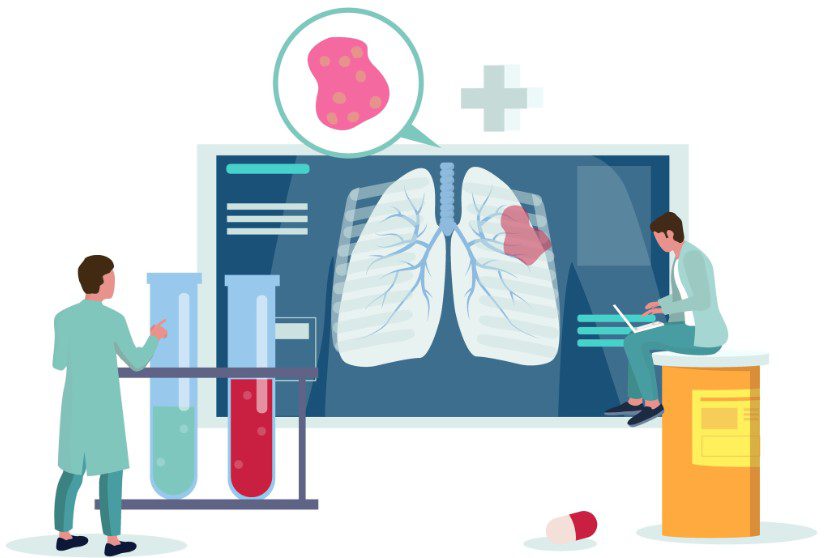Your Lung Cancer Treatment Team
Lung cancer can cause a great deal of uncertainty, but there is a team of highly trained professionals whose job it is to help you with these difficult times.
 Among the most important decisions that you will make along your journey is who the members of your healthcare team will be. It is easy to become a passive observer as your healthcare team is assembling if you have just been diagnosed with a life-altering condition.
Among the most important decisions that you will make along your journey is who the members of your healthcare team will be. It is easy to become a passive observer as your healthcare team is assembling if you have just been diagnosed with a life-altering condition.
Perhaps you have regular checkups at a primary care physician who takes your insurance and is convenient to your work. And then you see specialists and attend clinics and hospitals recommended by this doctor. Before you know it, this group of individuals, who will play an essential role in determining the course of your journey and its success, has been put together without much input at all from its most important member: YOU
Your Treatment Team and what you should know
Lung cancer can cause a great deal of uncertainty, but there is a team of highly trained professionals whose job it is to help you with these difficult times.
The number of people you meet and the information you receive about therapy can be overwhelming and confusing. The following information will introduce you to potential members of your cancer care team.
MEDICAL ONCOLOGIST:
A medical oncologist is a physician who specializes in medical management of cancer with systemic therapy (chemotherapy, targeted therapy, and immunotherapy).
You may encounter them in the outpatient clinic or in the hospital and it is important to find a medical oncologist that specializes in lung cancer. The medical oncologist reviews the medical history, pathology, tumor mutational status, diagnostic tests, and performs a physical examination. Treatment recommendations are based on this information as well as the stage of the disease, physical condition, functional status, and history of previous treatment for cancer. However, treatment of lung cancer varies from one person to another, and the type of systemic therapy prescribed will depend on the specifics of your disease.
THORACIC SURGEON:
A thoracic surgeon is a physician who specializes in chest surgery, which includes the chest wall, mediastinum, lungs, esophagus and diaphragm. They perform diagnostic procedures and surgical treatment for patients with lung cancer. This may involve obtaining laboratory tests or specialized studies. Prior to treatment, they will discuss the options for surgery and be the primary physicians managing your care in the hospital after surgery.
RADIATION ONCOLOGIST:
A radiation oncologist is a physician who specializes in the use of radiation therapy to treat cancer. Their focus is to design a treatment plan and direct radiation therapy. Radiation oncologists work closely with an array of other health care providers including: radiation oncology nurses, medical physicists, radiation therapists, and dosimetrists. They will help you choose the most effective radiation therapy for your cancer.
A radiation oncologist is a physician who specializes in the use of radiation therapy to treat cancer. Their focus is to design a treatment plan and direct radiation therapy. Radiation oncologists work closely with an array of other health care providers including: radiation oncology nurses, medical physicists, radiation therapists, and dosimetrists. They will help you choose the most effective radiation therapy for your cancer.
PATHOLOGIST:
A pathologist is a physician who specializes in the anatomic, cellular, and chemical changes that occur with diseases. Their role in lung cancer treatment is to provide a diagnosis by examining tissue under a microscope.
SOCIAL WORKER:
A social worker is a healthcare team member with psychology training who helps patients deal with mental, emotional, and daily living issues.
MIND-BODY THERAPIES:
These combine mental focus, breathing, and body movements to help relax the body and mind. Some examples are:
– Meditation: Focused breathing or repetition of words or phrases to quiet the mind.
– Biofeedback: Using simple machines, the patient learns how to affect certain body functions that are normally out of one’s awareness (such as heart rate).
– Hypnosis: A state of relaxed and focused attention in which a person concentrates on a certain feeling, idea, or suggestion to aid in healing.
– Yoga: Systems of stretches and poses, with special attention given to breathing.
– Tai Chi: Involves slow, gentle movements with a focus on the breath and concentration.
– Imagery: Imagining scenes, pictures, or experiences to help the body heal.
– Creative outlets: Interests such as art, music, or dance.
MANIPULATIVE & BODY-BASED PRACTICES:
These are based on working with one or more parts of the body. Some examples are:
– Massage: The soft tissues of the body are kneaded, rubbed, tapped, and stroked.
– Chiropractic therapy: A type of manipulation of the spine, joints, and skeletal system.
– Reflexology: Using pressure points in the hands or feet to affect other parts of the body.
RADIOLOGIST:
A radiologist is a physician who specializes in reading body imaging
(x-rays, computed tomography (CT) scans, and positron emission tomography (PET) scans). They aid in diagnosis of lung cancer and can perform CT-guided biopsies of tumors.
PULMONOLOGIST:
A pulmonologist is a physician who specializes in diseases of the airway and lungs. If you are found to have a “spot” (or nodule) on your lungs on chest x-ray or CT scan, they may be the first physicians you will see in a consultation. Their focus is to help determined if the nodule is lung cancer and aid in obtaining a diagnosis. This includes performing various procedures such as bronchoscopy and biopsies.
NURSE NAVIGATOR:
A nurse navigator is a trained nurse who works with you, your family, and your local doctor to guide you through the patient care process.
PHYSICIAN ASSISTANT, NURSE PRACTITIONER:
Physician assistants (PA) and nurse practitioners (NP) are medical professionals who work as part of the care team both in the outpatient clinic and in the hospital setting. In addition to assisting with your treatment, they are great resources for information and can be a direct line of communication to your physicians.
ONCOLOGY REGISTERED DIETICIAN:
An oncology registered dietician helps to address nutrition issues that become barriers to healing in treatment.
COMPLEMENTARY MEDICINE:
Complementary Medicine is a group of diverse medical and health care systems, practices, and products that are not generally considered part of western medicine. Complementary therapies can often help improve quality of life for individuals living with long-term disease and improve health outcomes. We encourage you to explore the different health care systems from around the world. When searching for a qualified practitioner, do your homework. Ask questions about their experiences treating people with the same disease as you . Ask for their results and what you should expect as an outcome of the intervention.
BIOLOGICALLY BASED PRACTICES:
This type of CAM uses things found in nature. Some examples are:
-Vitamins and dietary supplements.
– Botanicals, which are plants or parts of plants. One type is cannabis.
– Herbs and spices such as turmeric or cinnamon.
– Special foods or diets.
WHOLE MEDICAL SYSTEMS:
These are healing systems and beliefs that have evolved over time in different cultures and parts of the world. Some examples are:
– Ayurvedic medicine: A system from India in which the goal is to cleanse the body and restore balance to the body, mind, and spirit.
– Traditional Chinese medicine: Based on the belief that health is a balance in the body of two forces called yin and yang. –Acupuncture is a common practice in Chinese medicine that involves stimulating certain points on the body to promote health, or to lessen disease symptoms and treatment side effects.
– Homeopathy: Uses very small doses of substances to trigger the body to heal itself.
– Naturopathic medicine: Uses various methods that help the body naturally heal itself. An example would be herbal treatments.

